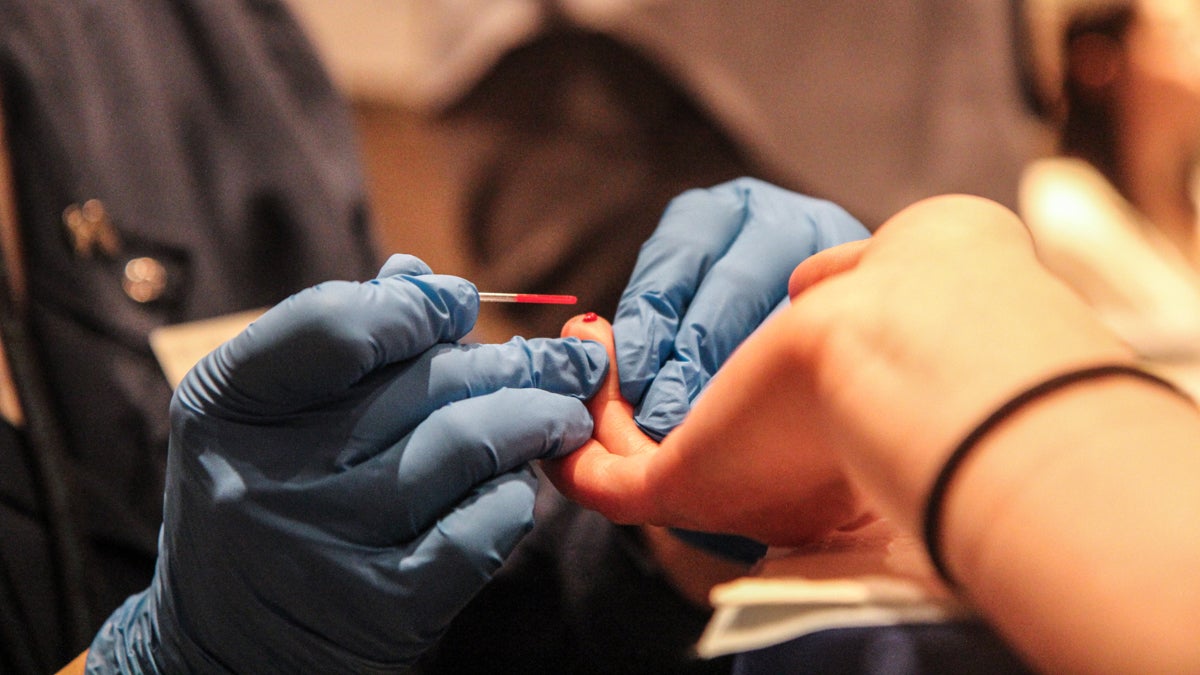Lead stirred up by Sandy may be impacting health on the shore
Listen
Blood is drawn for lead testing at a health fair in a county affected by Hurricane Sandy. (Kimberly Paynter/WHYY)
Hurricane Sandy devastated the New Jersey Shore nearly three years ago, but its long-term effects are still being uncovered.
According to New Jersey Department of Health data, about six percent of children tested in seven Sandy-affected counties have lead levels in their blood above five micrograms per liter, the federally recommended level for public health interventions.
Those children were identified by special lead-testing programs funded with federal disaster relief money running through June in eight Sandy-impacted counties in New Jersey.
Storm surge may have churned up long-buried lead
If inhaled or ingested, lead can cause developmental delays, behavioral problems and stunted growth in children, miscarriages in pregnant women, and neurological problems in adults.
Its long-term effects are often slow to emerge and shorter-term symptoms—including abdominal pain, irritability, and memory loss—can often be attributed to other causes, so lead-testing is necessary to catch dangerous levels early.
Kathy Lardiere, director of public health nursing services for the Ocean County Health Department, said the same storm surges that washed boats, washing machines and other trash onto yards could also have deposited trace amounts of lead.
“All that water was pulling debris from the bottom of the ocean, from the bays, and churning it all up,” Lardiere said. “Lead might have been sitting down there for a long period of time, but it now was moved by the water to new locations.”
Lardiere said there are many potential pathways for lead to enter the body: Residents demolishing homes built prior to 1978 could have exposed long covered-over lead paint. Or, lead from huge debris piles where destroyed housing materials and trash were deposited after the storm could have migrated.
“It only takes a little speck of lead to cause lead poisoning when it’s ingested,” Lardiere said. “If those debris piles were near playgrounds [or] homes, a little bit of wind could have blown that lead-impacted dust and soil to where people would be exposed.”
“Left in little nooks and crannies”
Ocean County assistant public health coordinator Matthew Csik said even after people strip and scrub their homes, lead can linger.
“It can be left in little nooks and crannies that you really can’t get to,” Csik said. “It can be that people were handling debris and that paint then chipped off that may have been after you’ve already gutted the first, say, four feet of your walls.”
As part of the lead-testing grant, Csik’s team is visiting homes for residents who ask for testing and collecting soil samples from at least 30 high-risk zones around the county, focusing on old debris pile sites. Csik said old lead-based paint or lead pipes or solder may have been among the construction and demolition debris stored there.
“We’d want to look at that property where that pile was to see what could have leeched into the soil, what could have blown into the soil, those types of things,” Csik said.
A study conducted after Hurricane Katrina demolition and re-building found nearly two-thirds of homes and yards tested in New Orleans had higher than recommended lead levels.
Csik, whose testing runs from this April to the end of September, doesn’t think the results will be as bad on the New Jersey shore, where houses are newer.
“New Jersey just simply is a little less likely to have the residential lead-based paint as the source, but that’s why the grant is looking at things like debris management areas, water towers, things like that,” Csik said.
The lead testing programs target those impacted by Sandy, including construction and demolition workers and residents whose homes were damaged by the storm. For residents with elevated levels, it is important to find and remove the metal from the home and get follow-up testing to ensure lead levels reduce over time. In extreme cases, lead poising can require hospitalization.
Preliminary data from the seven Sandy-impacted counties suggest lead levels after Sandy may be slightly higher than those before, though state public health officials caution that differences in testing programs before and after the storm make comparison difficult.
WHYY is your source for fact-based, in-depth journalism and information. As a nonprofit organization, we rely on financial support from readers like you. Please give today.



